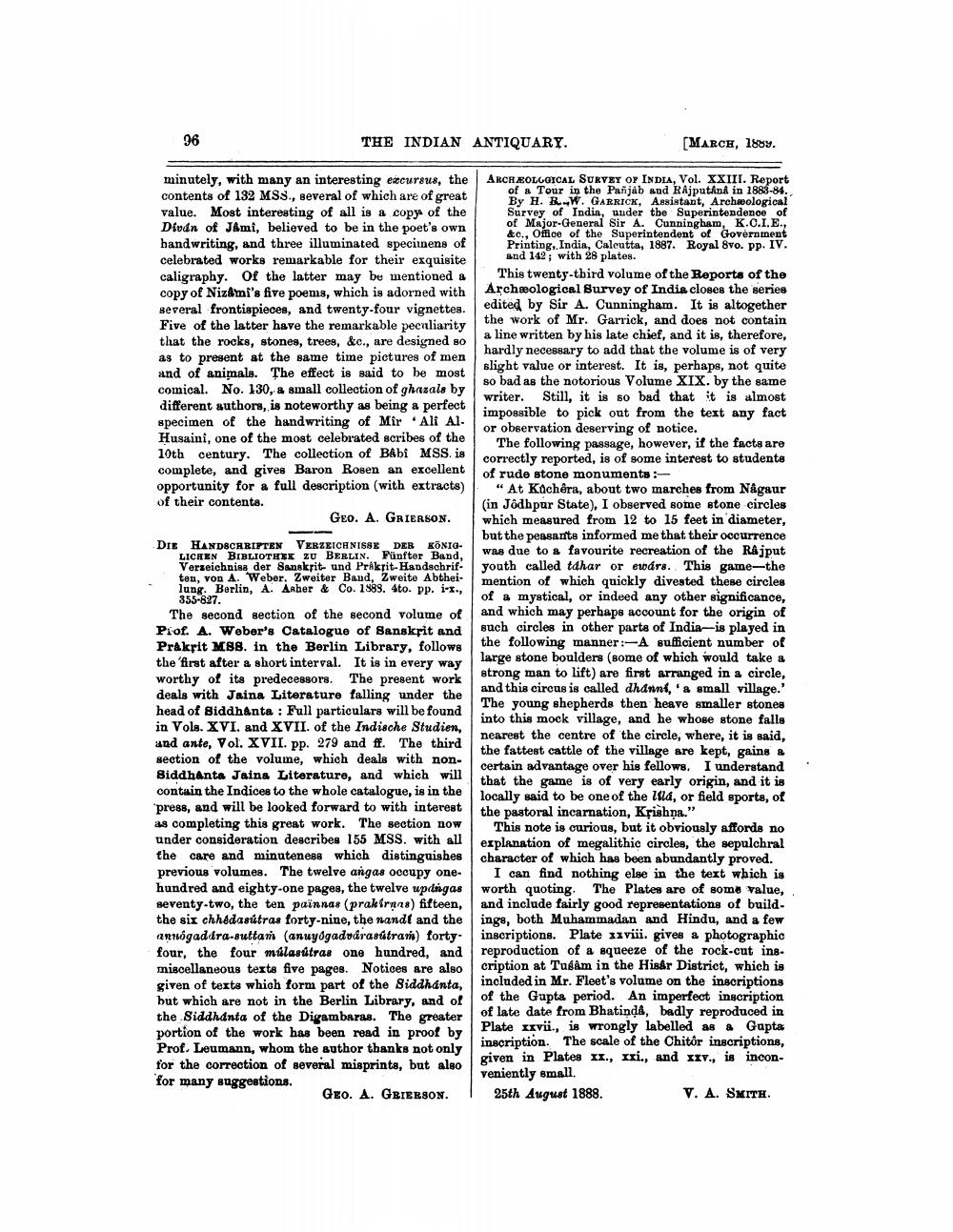________________
96
THE INDIAN ANTIQUARY.
[MARCH, 1889.
EN VERZ BERLIN.
Handschrank
minutely, with many an interesting excursus, the ARCHEOLOGICAL SURVEY OF INDIA, Vol. XXIII. Report contents of 132 MSS., several of which are of great
of a Tour in the Panjab and Rajputând in 1883-84.
By H. B.W. GARRICK, Assistant, Archeological value. Most interesting of all is a copy of the Survey of India, under the Superintendence of Divan of J&mi, believed to be in the poet's own
of Major-General Sir A. Cunningham, K.O.I.E.
&c., Office of the Superintendent of Government handwriting, and three illuminated specimens of Printing, India, Calcutta, 1887. Royal 8vo. pp. IV. celebrated works remarkable for their exquisite and 142; with 28 plates. caligraphy. Of the latter may be mentioned
o the latter may be mentioned This twenty-tbird volume of the Reports of the copy of Nizami's five poems, which is adorned with Archaeological Survey of India closes the series several frontispieces, and twenty-four vignettes.
| edited by Sir A. Cunningham. It is altogether Five of the latter have the remarkable peculiarity
the work of Mr. Garrick, and does not contain
a line written by his late chief, and it is, therefore, that the rocks, stones, trees, &c., are designed so
hardly necessary to add that the volume is of very as to present at the same time pictures of men
slight value or interest. It is, perhaps, not quite and of animals. The effect is said to be most
so bad as the notorious Volume XIX. by the same comical. No. 130, a small collection of ghazals by
writer. Still, it is so bad that it is almost different authors, is noteworthy as being a perfect
impossible to pick out from the text any fact specimen of the handwriting of Mir Ali Al.
or observation deserving of notice. Husaini, one of the most celebrated scribes of the
The following passage, however, if the facts are 10th century. The collection of Babi MSS.is
correctly reported, is of some interest to studente complete, and gives Baron Rosen an excellent
of rude stone monuments : opportunity for a full description (with extracts) "At Kochêra, about two marches from Nagaur of their contents.
(in Jodhpur State), I observed some stone circles Geo. A. GRIERSON. which measured from 12 to 15 feet in diameter,
but the peasants informed me that their occurrence DIE HANDSCHRIFTEN VERZEICHNISSE DER KÖNIGLICHEN BIBLIOTEEK ZU BERLIN. Fünfter Band,
was due to a favourite recreation of the Rajput Verzeichniss der Sanskrit- und Prakrit-Handschrif youth called tdhar or ewdrs. This game-the ten, von A. Weber. Zweiter Band, Zweite Abtheilung. Berlin, A. Asher &
mention of which quickly divested these circles
Co. 1889. 4to. Pp. i I., 355-827.
of a mystical, or indeed any other significance, The second section of the second volume of and which may perhaps account for the origin of Piof. A. Weber's Catalogue of Sanskrit and
such circles in other parts of India-is played in Prakrit M88. in the Berlin Library, follows
the following manner:-A sufficient number of the 'first after a short interval. It is in every way
large stone boulders (some of which would take a
strong man to lift) are first arranged in a circle. worthy of its predecessors. The present work deals with Jaina Literature falling under the
and this circus is called dhanni, a small village.' head of Siddhanta : Full particulars will be found
The young shepherds then heave smaller stones
into this mock village, and he whose stone falls in Vols. XVI. and XVII. of the Indische Studien, and ante, Vol. XVII. pp. 279 and ff. The third
nearest the centre of the circle, where, it is said,
the fattest cattle of the village are kept, gains & section of the volume, which deals with non
certain advantage over his fellows. I understand Siddhanta Jaina Literature, and which will
that the game is of very early origin, and it is contain the Indices to the whole catalogue, is in the
locally said to be one of the Zild, or field sports, of "press, and will be looked forward to with interest
the pastoral incarnation, Krishna." as completing this great work. The section now
This note is curious, but it obviously afforda no under consideration describes 155 MSS. with all explanation of megalithic circles, the sepulchral the care and minuteness which distinguishes character of which has been abundantly proved. previous volumes. The twelve angas occupy one- I can find nothing else in the text which is hundred and eighty-one pages, the twelve updagas worth quoting. The Plates are of some value, seventy-two, the ten painnas (prakirnas) fifteen, and include fairly good representations of build. the six chhedasútras forty-nine, the nandi and the inge, both Muhammadan and Hindu, and a few annógaddra-suttam (anuyðgadvarasátran forty | inscriptions. Plate xxviii. gives a photographic four, the four múlasútras one hundred, and reproduction of a squeeze of the rock-cut insmiscellaneous texts five pages. Notices are also cription at Tugam in the Hisêr District, which is given of texts which form part of the Siddhanta, included in Mr. Fleet's volume on the inscriptions but which are not in the Berlin Library, and of
of the Gupta period. An imperfect inscription the Siddhanta of the Digambaras. The greater
of late date from Bhatinda, badly reproduced in portion of the work has been read in proof by
Plate xxvü., is wrongly labelled as a Gupta Prof. Leumann, whom the author thanks not only
inscription. The scale of the Chitor inscriptions,
given in Plates IX., xxi., and XIV., is inconfor the correction of several misprints, but also
veniently small for many suggestions. GEO. A. GBIERSON. | 25th August 1888.
V. A. SMITH




